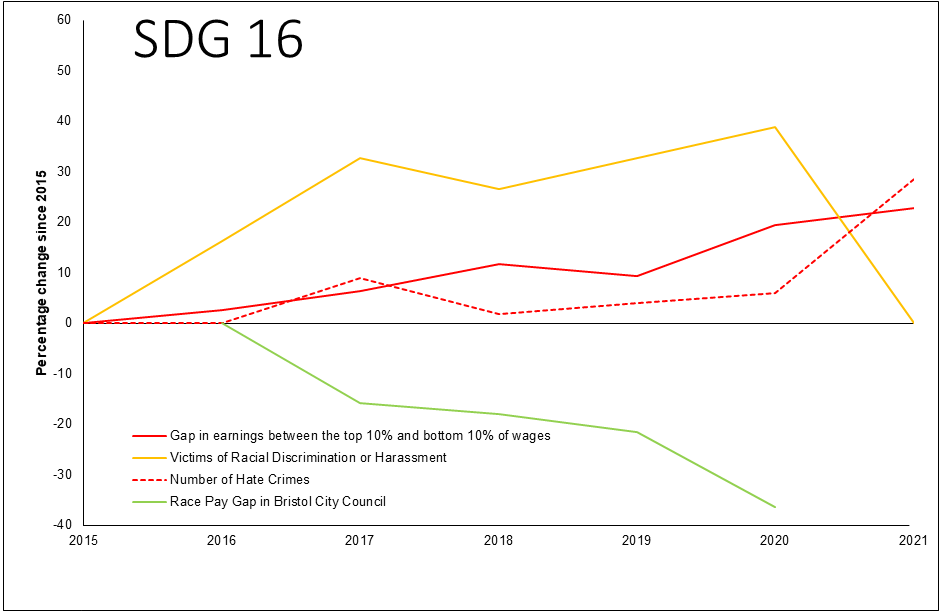SDG 16: Peace, justice and strong institutions
What does the data show?
Violent crime, sexual offences and domestic abuse
There has been negative performance against several crime indicators, but these results broadly follow a nationwide trend of rising crime rates.
Violent crime offences per 1,000 population in Bristol increased from 19.3 in 2015 to 33.1 in 2020/21, above England’s average of 29.5. Sexual offences per 1,000 population rose from 1.8 in 2015 to 2.6 in 2020/21, again above England’s average of 2.3. Domestic abuse-related incidents and crime per 1,000 increased from 18.5 in 2016 to 25.2 in 2020/21 but has consistently remained below the national average of 30.3 which has followed a similar rising trend.
Human trafficking
In the Avon and Somerset Constabulary there were 551 cases of human trafficking reported between 2015 and 2021. There were 70 cases in 2016, a peak of 152 cases in 2019 and 150 in 2020.
Fear of crime
The proportion of citizens whose fear of crime affects their day-to-day lives was 12.5% in 2015 rising to 19.4% in 2021. This fear of crime was felt most strongly by women, people from ethnic minorities, and young people aged 16 to 24, highlighting the need for the city to tackle this issue if it is to ensure no one is left behind.
Crime in young people
The rate of first-time entrants to the Youth Justice System decreased from 699.1 young people per 100,000 in 2015 to 215.7 in 2021. This is still above the England average of 146.9 per 100,000. These two numbers are far closer than in 2015 when the Bristol average (699.1) was nearly double the England average (374.9) and so the Bristol gap has been closing.
SDG 16: Peace, justice and strong institutions
Violent crime and sexual offence have risen since 2015, with Bristol’s figures above the national average. Cases of domestic abuse have risen throughout the country, but Bristol remains below the national average.
A fear of crime, felt most strongly by women, people from ethnic minorities, and young people aged 16 to 24, highlights the need for the city to tackle this issue if it is to ensure no one is left behind.
Conversely, the rate of first-time entrants to the Youth Justice System has decreased between 2015 and 2021.
The proportion of people who are satisfied with the way the council runs the city increased from 36% to 39.2% between 2015 and 2021. The percentage of those who believe they can influence decisions affecting their local area decreased from 25.3% in 2015 to 20.6% in 2021.
What Bristol is doing
Business Crime Reduction Partnership
Bristol’s Business Crime Reduction Partnership, established in 2019, is a collaboration between Avon and Somerset Police, Bristol City Council and city businesses that span day and night-time economies.
Supporting those living on streets
The Street Intervention Service is a multi-agency initiative that strives to tackle antisocial behaviour by providing housing, addressing substance misuse and supporting the health and finances of people living on Bristol’s streets.
Youth Summit on Violence Reduction
The city has also been collaborating to tackle violent crime among young people, and in 2022, held a Youth Summit on Violence Reduction. The summit, supported by the City Office and Bristol’s Youth Council, aimed to coordinate collaborative action from communities, youth providers, police and families across the city to tackle the root causes of violent crime.
The Keeping Bristol Safe Partnership
The Keeping Bristol Safe Partnership (KBSP) consists of Bristol City Council, the NHS Bristol, North Somerset and South Gloucestershire Clinical Commissioning Group, Avon and Somerset Police and community and voluntary groups. KBSP’s remit covers child and adult safeguarding, domestic abuse and crisis services. The partnership’s collaborative multi-agency approach allows for efficient place-specific responses.
Trends in crime, slavery and perceived safety
